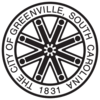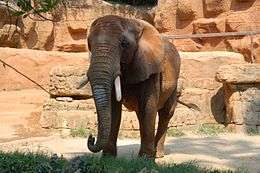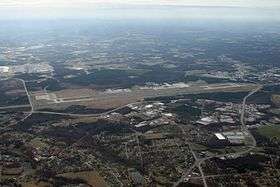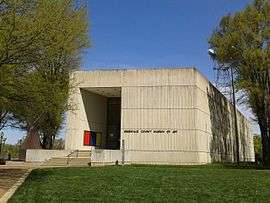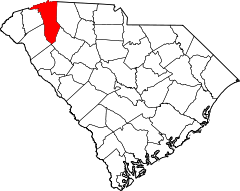Greenville, South Carolina
| Greenville, South Carolina | |||
|---|---|---|---|
| City | |||
| City of Greenville | |||
|
Clockwise from top left: Downtown Greenville, Peace Center, Reedy River, Furman University, Falls Park on the Reedy | |||
| |||
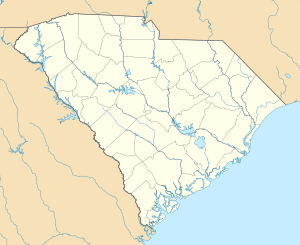 Greenville Location neighbin South Carolina | |||
| Coordinates: 34°50′40″N 82°23′8″W / 34.84444°N 82.38556°WCoordinates: 34°50′40″N 82°23′8″W / 34.84444°N 82.38556°W | |||
| Country |
| ||
| State |
| ||
| County | Greenville | ||
| Founded | 1831 | ||
| Government | |||
| • Mayor | Knox H. White (R) | ||
| Area | |||
| • City | 26.1 sq mi (67.6 km2) | ||
| • Land | 26.0 sq mi (67.3 km2) | ||
| • Water | 0.1 sq mi (0.3 km2) 0.4% | ||
| • Urban | 320 sq mi (830 km2) | ||
| • Metro | 2,790 sq mi (7,220 km2) | ||
| Elevation | 966 ft (294 m) | ||
| Population (2010) | |||
| • City | 58,409 | ||
| • Estimate (2015) | 64,579 | ||
| • Rank | SC: 6th | ||
| • Density | 2,474/sq mi (955.3/km2) | ||
| • Urban | 400,492 (US: 93rd) | ||
| • MSA (2015) | 874,869 (US: 63rd) | ||
| • CSA (2015) | 1,426,625 (US: 40th) | ||
| Time zone | EST (UTC−5) | ||
| • Summer (DST) | EDT (UTC−4) | ||
| ZIP codes | 29601-29617 | ||
| Area code | 864 | ||
| FIPS code | 45-30850 | ||
| GNIS feature ID | 1245842[1] | ||
| Website |
www | ||
Greenville (/ˈɡriːnvɪl/; locally /ˈɡriːnvəl/) is the county seat of Greenville County in the upstate region of the state of South Carolina, in the United States.[2] The city's mayor is Knox White, who has served as the mayor of Greenville since December 1995.[3] With a population of 64,579 as of 2015,[4] it is the sixth-largest municipality in the state. The population of the surrounding area was 400,492 as of 2010,[5] making it the third-largest urban area in South Carolina as well as the fastest growing. Greenville is the largest city in the Greenville-Anderson-Mauldin Metropolitan Statistical Area. The MSA had a population of 874,869 in 2015,[6] making it the largest in South Carolina and the third largest in the Carolinas.
Greenville is the largest city in the Greenville-Spartanburg-Anderson Combined Statistical Area. According to United States Census Bureau, the CSA had a population of 1,426,625 as of 2015,[7] making it the largest CSA in the state. The CSA, a 10-county region of northwestern South Carolina, is known as "The Upstate". Greenville is located approximately halfway between Atlanta and Charlotte, North Carolina along Interstate 85, and its metropolitan area also includes Interstates 185 and 385.
Greenville has gained recognition in various national publications such as CNN Money, which ranked Greenville as one of the "Top 10 Fastest Growing Cities in the U.S." Bloomberg named Greenville the 3rd Strongest Job Market, 2010; and Forbes named Greenville the 13th Best City for Young Professionals.
History
Cherokee Land

The land of present-day Greenville was once the hunting ground of the Cherokee which was forbidden to colonists. A settler named Richard Pearis married a Cherokee woman and received about 100,000 acres (40,000 ha) from the Cherokee around 1770. Pearis established a plantation on the Reedy River called the Great Plains in present-day downtown Greenville. The American Revolution divided the South Carolina country between the Loyalists and Patriots. Pearis supported the Loyalists and together with their allies the Cherokee attacked the Patriots. The Patriots retaliated by burning down Pearis' plantation and jailing him in Charleston. Pearis never returned to his plantation but Paris Mountain is named after him.[8] The Treaty of Dewitt's Corner in 1777 ceded almost all Cherokee land, including present-day Greenville, to South Carolina.[9]
From Pleasantburg to Greenville
Greenville County was created in 1786 and was named for its physical appearance.[10] Lemuel J. Alston came to Greenville County in 1788. Alston bought 400 acres (160 ha) and a portion of Pearis' former plantation. In 1797 Alston used his land holdings to establish a village called Pleasantburg where he also built a stately mansion. Vardry McBee purchased Alston's land in 1816 who then leased the Alston mansion for a summer resort. McBee decided to make the mansion his home in 1835 until his death in 1864. Considered to be the father of Greenville, McBee donated land for many structures such as churches, academies and a cotton mill. Furman University was funded by McBee who helped bring the university to Pleasantburg from Winnsboro, South Carolina in 1851. In 1853 McBee and other Greenville County leaders funded a new railroad called the Greenville and Columbia Railroad. Pleasantburg boomed to around 1,000 in the 1850s due to the growth of McBee's donations and the attraction of the town as a summer resort for visitors.[11][12] In 1831 Pleasantburg was incorporated as Greenville.[13]
Modern Greenville
In December 1860 Greenville supported a convention to debate the issue of secession for South Carolina. The Greenville District sent James Furman, William K. Easley, Perry E. Duncan, William H. Campbell, and James P. Harrison as delegates for the convention. On December 20, 1860 the South Carolina state convention, along with the Greenville delegation, voted to secede from the Union. Greenville County provided over 2,000 soldiers to the Confederate States Army. The town supplied food, clothing, and firearms to the Confederacy. Greenville saw no action from the war until 1865 when Federal troops came through the town looking for President Jefferson Davis of the Confederacy who had fled south from Richmond, Virginia. In June 1865 Andrew Johnson appointed Greenville County native Benjamin Franklin Perry as Governor of South Carolina.[11][14]

In February 1869, Greenville's town charter was amended by the S. C. General Assembly establishing Greenville, the town, as a city. Construction boomed in the 1870s such as the establishment of a bridge over the Reedy River, new mills on the river and new railroads. The Greenville News was established in 1874 as Greenville's first daily newspaper. Southern Bell installed the first telephone lines in the city. The most important infrastructure that came to the city were cotton mills. Prominent cotton mill businesses operated near Greenville making it a cotton mill town. By 1915 Greenville became known as the "Textile Center of the South."[11]
During World War I, Greenville served as a training camp center for Army recruits. After World War I commercial activity expanded with new movie theaters and department stores. The Mansion House was demolished and replaced with the Poinsett Hotel in 1925.[11] The Great Depression hurt the economy of Greenville forcing mills to lay off workers. Furman University and the Greenville Women's College also struggled in the crippling economy forcing them to merge in 1933. The Textile Workers Strike of 1934 caused such an uproar in the city and surrounding mill towns that the National Guard had to subdue the chaos. The New Deal established Sirrine Stadium and a new Greenville High School. The Greenville Army Air Base was established in 1942 during World War II contributing to the further growth of Greenville.[11]
The last lynching in the South Carolina occurred in Greenville on February 16, 1947, when Willie Earle, accused of stabbing a cab driver, was taken from his jail cell by mob and murdered. Thirty-one men were tried and acquitted of the crime.[15]
After World War II Greenville's economy surged with the establishment of new downtown stores and the expansion of the city limits. Furman University doubled its student population and moved to a new location. Higher education facilities such as Bob Jones University in 1947 and Greenville Technical College in 1962 were established in Greenville. The Greenville–Spartanburg International Airport was established in nearby Greer in 1962. The economy of Greenville finally waned in the 1970s leaving a void in downtown Greenville due to the flight of many retailers. Mayor Max Heller revitalized downtown Greenville by establishing the Greenville County Museum of Art and the Hughes Main Library. Main Street was then converted into a two-lane road lined with trees and sidewalks.[16]
Geography
Greenville is located at 34°50′40″N 82°23′8″W / 34.84444°N 82.38556°W (34.844313, −82.385428),[17] roughly equidistant between Atlanta (120 miles [190 km] southwest), and Charlotte, North Carolina.
Greenville is in the foothills of the Blue Ridge Mountains, a physiographic province of the larger Appalachian Mountains range, and includes many small hills. Sassafras Mountain, the highest point in South Carolina, is in northern Pickens County, which adjoins Greenville County to the west. Many area television and radio station towers are on Paris Mountain, the second most prominent peak in the area, less than seven miles (11 km) from downtown Greenville. According to the United States Census Bureau, Greenville has a total area of 26.1 square miles (68 km2), of which 26.1 square miles (68 km2) is land and 0.1 square miles (0.26 km2) is water.
Greenville is located in the Brevard Fault Zone and has had occasional earthquakes, though they are minor.
Climate
Greenville, like much of the Piedmont region of the southeastern United States, has a humid subtropical climate (Köppen Cfa), with four distinct seasons; the city is part of USDA Hardiness zone 7b/8a.[18] Winters are short and generally cool, with a January daily average of 42.2 °F (5.7 °C). On average, there are 59 nights per year that drop to or below freezing, and only 1.3 days that fail to rise above freezing.[19] April is the driest month, with an average of 3.36 inches (85 mm) of precipitation.
Summers are hot and humid, with a daily temperature average in July of 79.9 °F (26.6 °C). There are an average 43 days per year with highs at or above 90 °F (32 °C).[19] Official record temperatures range from 107 °F (42 °C) on July 1, 2012, down to −6 °F (−21 °C) on January 30, 1966; the record cold daily maximum is 19 °F (−7 °C) on December 31, 1917, while, conversely, the record warm daily minimum is 80 °F (27 °C) on July 12, 1937, the last of three occasions.[19] The average window for freezing temperatures is November 4 thru April 1, allowing a growing season of 217 days.[19]
Precipitation is generally less frequent in autumn than spring [19] and, on average, Greenville receives 47.2 inches (1,200 mm) of precipitation annually, which is somewhat evenly distributed throughout the year, although summer is slightly wetter; annual precipitation has historically ranged from 31.08 in (789 mm) in 2007 to 72.53 in (1,842 mm) in 1908.[19] In addition, there is an average of 4.7 inches (11.9 cm) of snow, occurring mainly from January thru March, with rare snow occurring in November or April. More frequent ice storms and sleet mixed in with rain occur in the Greenville area; seasonal snowfall has historically ranged from trace amounts as recently as 2011–12 to 21.4 in (54 cm) in 1935–36.[19] These storms can have a major impact on the area, as they often pull tree limbs down on power lines and make driving hazardous.
| Climate data for Greenville, South Carolina (Greenville–Spartanburg Int'l), 1981–2010 normals,[lower-alpha 1] extremes 1884–present[lower-alpha 2] | |||||||||||||
|---|---|---|---|---|---|---|---|---|---|---|---|---|---|
| Month | Jan | Feb | Mar | Apr | May | Jun | Jul | Aug | Sep | Oct | Nov | Dec | Year |
| Record high °F (°C) | 82 (28) |
81 (27) |
91 (33) |
94 (34) |
100 (38) |
105 (41) |
107 (42) |
105 (41) |
101 (38) |
97 (36) |
86 (30) |
79 (26) |
107 (42) |
| Mean maximum °F (°C) | 69.4 (20.8) |
72.5 (22.5) |
80.8 (27.1) |
86.0 (30) |
90.2 (32.3) |
95.1 (35.1) |
97.3 (36.3) |
95.9 (35.5) |
91.1 (32.8) |
84.4 (29.1) |
77.1 (25.1) |
69.5 (20.8) |
98.6 (37) |
| Average high °F (°C) | 52.4 (11.3) |
56.6 (13.7) |
64.5 (18.1) |
72.8 (22.7) |
80.2 (26.8) |
87.5 (30.8) |
90.3 (32.4) |
88.6 (31.4) |
82.2 (27.9) |
72.8 (22.7) |
63.5 (17.5) |
54.1 (12.3) |
72.1 (22.3) |
| Average low °F (°C) | 32.0 (0) |
34.9 (1.6) |
41.2 (5.1) |
48.3 (9.1) |
57.2 (14) |
65.8 (18.8) |
69.4 (20.8) |
68.7 (20.4) |
61.8 (16.6) |
50.4 (10.2) |
41.3 (5.2) |
34.0 (1.1) |
50.4 (10.2) |
| Mean minimum °F (°C) | 14.6 (−9.7) |
19.0 (−7.2) |
24.2 (−4.3) |
32.6 (0.3) |
42.7 (5.9) |
55.0 (12.8) |
61.7 (16.5) |
60.7 (15.9) |
47.9 (8.8) |
34.1 (1.2) |
26.0 (−3.3) |
18.1 (−7.7) |
11.8 (−11.2) |
| Record low °F (°C) | −6 (−21) |
−5 (−21) |
11 (−12) |
22 (−6) |
27 (−3) |
40 (4) |
53 (12) |
50 (10) |
32 (0) |
25 (−4) |
11 (−12) |
3 (−16) |
−6 (−21) |
| Average precipitation inches (mm) | 3.82 (97) |
3.97 (100.8) |
4.52 (114.8) |
3.36 (85.3) |
3.76 (95.5) |
3.80 (96.5) |
4.80 (121.9) |
4.48 (113.8) |
3.43 (87.1) |
3.44 (87.4) |
3.70 (94) |
4.11 (104.4) |
47.19 (1,198.6) |
| Average snowfall inches (cm) | 2.3 (5.8) |
1.0 (2.5) |
0.9 (2.3) |
trace | 0 (0) |
0 (0) |
0 (0) |
0 (0) |
0 (0) |
0 (0) |
0.1 (0.3) |
0.4 (1) |
4.7 (11.9) |
| Average precipitation days (≥ 0.01 in) | 10.2 | 9.2 | 9.6 | 9.0 | 9.7 | 10.4 | 11.7 | 10.4 | 8.1 | 7.2 | 8.9 | 9.8 | 114.2 |
| Average snowy days (≥ 0.1 in) | 1.2 | 0.7 | 0.3 | 0.1 | 0 | 0 | 0 | 0 | 0 | 0 | 0.1 | 0.4 | 2.8 |
| Average relative humidity (%) | 65.8 | 62.6 | 62.1 | 60.7 | 68.5 | 70.5 | 74.0 | 75.6 | 75.8 | 70.9 | 68.2 | 67.7 | 68.5 |
| Mean monthly sunshine hours | 176.6 | 182.7 | 236.2 | 264.7 | 269.2 | 270.8 | 267.8 | 253.9 | 229.2 | 235.2 | 184.3 | 169.4 | 2,740 |
| Percent possible sunshine | 56 | 60 | 64 | 68 | 62 | 62 | 61 | 61 | 62 | 67 | 59 | 55 | 62 |
| Source: NOAA (relative humidity 1962–1990, sun 1961–1990)[19][20][21] | |||||||||||||
Law and government

The city of Greenville adopted the Council-Manager form of municipal government in 1976.[22] The Greenville City Council consists of the mayor and six council members. The mayor and two council members are elected at-large while the remaining council members are chosen from single-member districts. Greenville Municipal Court handles criminal misdemeanor violations, traffic violations, and city ordinance violations.[23]
The Greenville Police Department was established in 1845 as the Greenville Police Force. By 1876 the Greenville Police Force became the Greenville Police Department. In 1976 the Greenville Police Department moved into the Greenville County Law Enforcement Center with the Greenville County Sheriff's Department. The Greenville Police Department serves Greenville with around 241 employees with 199 sworn officers.[24]
Attractions
As the largest city in the Upstate, Greenville offers many activities and attractions. Greenville's theaters and event venues regularly host major concerts and touring theater companies. Four independent theaters present several plays a year.
Notable event venues
- Bon Secours Wellness Arena (formerly Bi-Lo Center), a 16,000-seat arena in downtown Greenville
- Peace Center, a performing arts center
- The Warehouse Theatre offers productions of live theater.
- Centre Stage, Greenville's Professional Theater is a year-round theater hosting the annual New Play Festival. It also hosts the Greenville Light Opera Works (GLOW), a professional operetta company.
- Timmons Arena, a 6,000 seat multi-purpose venue on the campus of Furman University.
- Fluor Field at the West End is the home of the Greenville Drive baseball team, the Class-A affiliate of the Boston Red Sox.
- TD Convention Center, a convention and meeting facility.
Landmarks
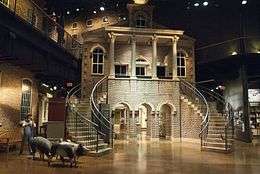
- Falls Park on the Reedy, a large regional park in the West End with gardens and several waterfalls, with access to the Swamp Rabbit Trail. Dedicated in 2004, the $15.0 million park is home to the Liberty Bridge, a pedestrian suspension bridge overlooking the Reedy River. The park's development sparked a $75 million public-private development, Riverplace, directly across Main Street. Falls Park has been called the birthplace of Greenville, but in the mid-20th century the area was in severe decline, and the Camperdown Bridge had been built across the Falls, obstructing view. In the mid-1980s, the City adopted a master plan for the park, leading to the removal of the Camperdown Bridge and making way for extensive renovations, to include 20 acres (81,000 m2) of gardens and the Liberty Bridge. While bridges with similar structural concepts have been built in Europe, the Liberty Bridge is unique in its geometry.
- Greenville County Museum of Art specializing in American art, frequently with a Southern perspective that dates back to the 18th century. It is noted for its collections of work by Andrew Wyeth and Jasper Johns, as well as a contemporary collection that features such notables as Andy Warhol, Georgia O'Keeffe, and others.
- Bob Jones University Museum and Gallery has two locations; the original is located on the campus of Bob Jones University at 1700 Wade Hampton Boulevard; the satellite location is located at Heritage Green in downtown Greenville.[25]
- Roper Mountain Science Center is home to a historic 23" refractor telescope, eighth largest of its kind in the United States.[26]
- Greenville Zoo was established in 1960 and is located in Cleveland Park
Festivals
- Euphoria Greenville is an annual three-day culinary event held in the Wyche Pavilion at Larkin's on the River, Art in the Park, and the Peace Center for the Performing Arts.[27]
- Fall for Greenville is a three-day music and food street festival held each fall.[28]
- Artisphere is a three-day art festival held each spring.[29]
- iMAGINE Upstate is a weeklong celebration and showcase of STEM, entrepreneurial, creative, and innovative activity in the Upstate held each spring.[30]
- Big Fandom Greenville is a three-day comic book and science fiction convention held each October.[31]
- SC Comicon is a two-day comic book convention held annually.[32]
- Indie Craft Parade is a festival of handmade art held each September.[33]
- The Upstate Shakespeare Festival performs Shakespeare and other classic plays each summer in Falls Park.[34]
- The Greek Festival a three-day festival put on by the Greek Orthodox Church in downtown Greenville to celebrate Greek culture.
- New South Comedy Festival is a four-day comedy festival featuring improvisational, stand-up, sketch, and musical comedy from around the country.[35]
Education
Public schools
The Greenville County School District is the largest school district in the state of South Carolina and ranked the 49th largest district in the United States, with 14 high schools, 18 middle schools, and 50 elementary schools in the district.[36][37] With a budget of $426 Million, the district employs 5,200 teachers, 63.1% of which hold a master's degree or higher.[38] In addition to traditional public schools, Greenville's downtown area is home to the South Carolina Governor's School for the Arts & Humanities, a boarding school for young artists.
Private schools

In addition to public schools, Greenville county has a number of private and religious schools, including St Mary's Catholic School (founded in 1900), Camperdown Academy (for students with learning disabilities),[39] Hidden Treasure Christian School (a school for students with physical and/or mental disabilities), Christ Church Episcopal School (a college-preparatory Episcopalian school with an American school outside of Germany certified by the Bavarian Ministry of Education),[40] Shannon Forest Christian School (an evangelical Christian school),[41] Saint Joseph's Catholic School, Southside Christian School (established in 1967 by Southside Baptist Church), Hampton Park Christian School,[42] and Bob Jones Academy and Elementary School.
Colleges and universities
Greenville has several colleges and universities that first began with Furman University. Furman began as Furman Academy and Theological Institution in 1825 named after Richard Furman. The theological school of Furman broke away in 1858 and became Southern Baptist Theological Seminary now in Louisville, Kentucky.[43] North Greenville University was established in 1893 and is affiliated with the South Carolina Baptist Convention.[44] Bob Jones University was established in 1927 by Bob Jones, Sr. as a private non-denominational Protestant university.[45] Greenville Technical College was established in 1962 as a technical college. Clemson University has a campus in Greenville called Clemson University International Center for Automotive Research that focuses on automotive research.[46] University of South Carolina also has a medical school in Greenville called the University of South Carolina School of Medicine Greenville that is a four-year medical school operating on the campus of the Greenville Health System.[47]
Economy
Greenville's economy was formerly based largely on textile manufacturing, and the city was long known as "The Textile Capital of the World." In the last few decades, favorable wages and tax benefits have lured foreign companies to invest heavily in the area. The city is the North American headquarters for Michelin, AVX Corporation, Ameco, CertusBank, and Scansource. In 2003, the International Center for Automotive Research was created, establishing CUICAR as the new model for automotive research. The Center for Emerging Technologies in mobility and energy was opened in 2011, hosting a number of companies in leading edge R&D and the headquarters for Sage Automotive.
When the former Donaldson Air Force Base closed, the land became the South Carolina Technology and Aviation Center, and became home to a Lockheed Martin aircraft and logistics center, as well as facilities operated by 3M and Honeywell. Donaldson Center Airport now occupies the former air base as a public airport. General Electric has a gas turbine, aviation and wind energy manufacturing operations located in Greenville.
Infrastructure
Health systems
Greenville has two main health systems, the Bon Secours St. Francis Health System and the Greenville Health System.
Bon Secours St. Francis Health System, which includes St. Francis Downtown; St. Francis Eastside; and St. Francis Outpatient Center and Upstate Surgery Center, is ranked among the best hospitals in the nation by HealthGrades for heart surgery and overall orthopedic services.
The extensive Greenville Health System (formerly known as Greenville Hospital System) is a not-for-profit academic medical center that includes seven campuses: Greenville Memorial Medical Center, North Greenville Long Term Acute Care Hospital and ER, Hillcrest Hospital, Patewood Memorial Hospital, Greer Memorial Hospital, Laurens County Memorial Hospital, and Oconee Memorial Hospital. It is one of the largest employers in the region. It was recognized for 2010–2011 as a top provider of Cardiac and Gastroenterology Care by U.S. News & World Report. GHS also boasts the only Children's Hospital in the Upstate region of South Carolina, with the majority of Pediatric Specialties represented for inpatient and outpatient care. GHS hosts a full four-year branch of the University of South Carolina School of Medicine. There are numerous residencies for training physicians at GHS including Pediatrics, Internal Medicine, Family Practice, OBGYN, General Surgery, Orthopedic Surgery and fellowships in Developmental Behavioral Pediatrics and Vascular Surgery.
Additionally, Greenville's Shriners Hospital for Children exclusively treats pediatric orthopaedic patients free of charge.
Transportation
Greenville is located on the Interstate 85 corridor, approximately halfway between Atlanta and Charlotte. The northern terminus of Interstate 385 is located downtown, and the area is also served by Interstate 185 and U.S. Highway 123 (Calhoun Memorial Highway). Other major highways include U.S. 25, U.S. 29 and U.S. 276.
There are several airports servicing the Greenville area. The largest in the region, Greenville-Spartanburg International Airport (GSP), is the second busiest in the state and is served by most major airlines. SCTAC (formerly Donaldson Air Base) has undergone significant moderization and is the site of the new South Carolina Army National Guard Aviation Support Facility (AASF) and proposed Super General Aviation Center. Greenville serves as a freight hub for FedEx Express. The Greenville Downtown Airport, is the busiest general aviation airport in South Carolina with nearly 80,000 take-offs and landings annually and more than 245 based aircraft.[48]
Public transit in Greenville is handled by the Greenville Transit Authority (GTA), which contracted out operations to the City Of Greenville in 2008 under a tri-party agreement with Greenville County. The city rebranded the service with the name Greenlink. Greenlink runs a bus system that serves the Greenville area, much of Greenville County including Mauldin and Simpsonville, and a portion of Pickens County via a connector to Clemson. Community leaders are in the early planning stages for a comprehensive transit system that will help ease the high traffic volume on interstates and roadways. Considerations include the expansion of the current Greenlink bus routes.
Greenville has an Amtrak station, which is part of Amtrak's Crescent, connecting Greenville with the cities of New York, Philadelphia, Baltimore, Washington, Charlotte, Atlanta, Birmingham and New Orleans. Additionally, Greenville is included in the proposed Southeast High Speed Rail Corridor, which will run from Washington, D.C. to Birmingham, Alabama. Freight railroad service is provided by CSX Transportation, Norfolk Southern Railway, and the Carolina Piedmont Railroad. The former Greenville and Northern Railway line to Travelers Rest has been abandoned and converted into a hiking and biking trail.
Interstates
Interstate 85 runs by Greenville going through Interstate 185 (Greenville) and Interstate 385. Interstate 385 ends in downtown Greenville and connects with Interstate 26. Interstate 185 connects Interstate 385 to Interstate 85 south of Greenville.
Sports teams Spectators at a Greenville Drive game Major League sports teams:
Minor League sports teams:
CultureGreenville has been named one of the "Top 100 Arts Small Towns in the United States." [50] The Bon Secours Wellness Arena brings national tours of many popular bands to downtown, and the Peace Center for the Performing Arts provides a venue for orchestras and plays. A planned multimillion-dollar renovation to the center's main concert hall lobby and riverside amphitheatre began in the spring of 2011.  The old Greenville County Courthouse Visual artA number of local artists operate studios and galleries in the city, especially the Village of West Greenville near downtown. The Metropolitan Arts Council and Upstate Visual Arts provide a number of public events that focus on the visual arts, including the First Fridays Art Walk, Greenville Open Studios, and the West Greenville Arts Festival. Greenville also provides some notable fine arts museums:
MusicGreenville's music scene features live performances by local jazz, country, and rock bands. Lynyrd Skynyrd played their last concert with all original members in Greenville, on October 19, 1977.[53][54] The city is home to the Greenville Symphony Orchestra, Greenville County Youth Orchestra, Carolina Youth Symphony, and the Carolina Pops Orchestra. The Boston Symphony Orchestra regularly performs at the Bon Secours Wellness Arena. Greenville Light Opera Works (GLOW Lyric Theatre) is a professional lyric theatre in Greenville that produces Musical Theatre, Operetta and Opera. The Palmetto Statesmen Barbershop Chorus and Quartets perform barbershop harmony and a cappella singing at various locations throughout the Upstate.[55] The Palmetto Statesmen Chorus is a member of the Barbershop Harmony Society. Greenville is also the home of the Greenville Chorale, a 160-voice choral group. Formed in 1993 by Greenville native Karl Sanders, world renowned Egyptian themed death metal band Nile is based in the city. ComedyThere are eight comedy venues in Greenville featuring stand up comedy, sketch comedy, ventriloquists, as well as experimental and non-traditional comedy.[56] Dance and TheaterThe Carolina Ballet Theatre is a professional dance company which regularly presents programs at the Peace Center and elsewhere. CBT presents four performances annually as the resident professional dance company of the Peace Center with their largest as the holiday classic, "The Nutcracker, Once Upon A Time in Greenville." This production is modelled after the major companies who have set their holiday class in their hometown. Centre Stage, Greenville Little Theater, South Carolina Children's Theater and the Warehouse Theatre are the major playhouses in the area. These theaters offer a variety of performances including well-known works, such as Death of a Salesman and Grease, and plays written by local playwrights. During the Spring and Summer, the local Shakespearean company performs Shakespeare in the Park at the Falls Park Amphitheater. Social DancingGreenville is also home to a thriving social dance scene. Regular social dances include: Upstate Swing has been putting on a weekly Tuesday swing dance since 1998, drawing hundreds of people every week to a beginner lesson, followed by a three-hour social dance.[57] The Greenville Lindy Hoppers meet weekly on Thursdays for beginner and intermediate Lindy Hop lessons, followed by a social dance. They also host The Greenville Lindy Exchange the last weekend of June every year, which draws hundreds of swing dancers from across the southeast to the Upstate.[58] Greenville Blues hosts blues dances in the Greenville area. The Carolina Shag Club meets weekly to promote Carolina Shag dancing in the Upstate area.[59] The Harvest Moon Folk Society meets weekly to host a Contra dance at the River Falls Lodge and hosts Contra events in the downtown Greenville area.[60] Media
TelevisionGreenville is part of the Greenville-Spartanburg-Anderson-Asheville DMA, which is the nation's 36th largest television market. See the box below for the local television stations: RadioGreenville is part of the Greenville-Spartanburg-Anderson Arbitron Metro which is the nation's 59th largest radio market with a person 12+ population of 813,700. See the box below for the local radio stations: Demographics
Greenville is the largest principal city of the Greenville-Anderson-Mauldin Metropolitan Statistical Area, a metropolitan area that covers Greenville, Laurens, Anderson and Pickens counties and had a combined population of 874,869 as of 2015.[6] Since South Carolina law makes annexing the suburban areas around cities difficult, Greenville's population is larger than what it is said to be. The 2010 city population was 58,409, while the total area population was 400,492. As of the census[22] of 2010, there were 58,409 people, 24,382 households, and 12,581 families residing in the city. The population density was 2,148.0 inhabitants per square mile (829.3/km2). There were 27,295 housing units at an average density of 1,046.9 per square mile (404.2/km2). The racial composition of the city was 62.12% White, 31.54% Black or African American, 3.44% Hispanic or Latino (of any race), 1.27% Asian, 0.14% Native American, 0.06% Pacific Islander, 1.37% of other races, and 1.11% of Two or more races. There were 29,418 households out of which 22.3% had children under the age of 18 living with them, 32.7% were married couples living together, 15.5% had a female householder with no husband present, and 48.4% were non-families. 40.8% of all households were made up of individuals and 12.8% had someone living alone who was 65 years of age or older. The average household size was 2.11 and the average family size was 2.90. In the city the age distribution of the population shows 20.0% under the age of 18, 13.8% from 18 to 24, 31.3% from 25 to 44, 20.5% from 45 to 64, and 14.4% who were 65 years of age or older. The median age was 35 years. For every 100 females there were 89.9 males. For every 100 females age 18 and over, there were 86.8 males. The median income for a household in the city was $33,144, and the median income for a family was $44,125. Males had a median income of $35,111 versus $25,339 for females. The per capita income for the city was $23,242. About 12.2% of families and 16.1% of the population were below the poverty line, including 22.7% of those under age 18 and 17.5% of those age 65 or over.
NeighborhoodsNeighborhoods within the City of Greenville include:
Notable people
Sister citiesNotes
References
External links
| ||||||||||||||||||||||||||||||||||||||||||||||||||||||||||||||||||||||||||||||||||||||||||||||||||||||||||||||||

